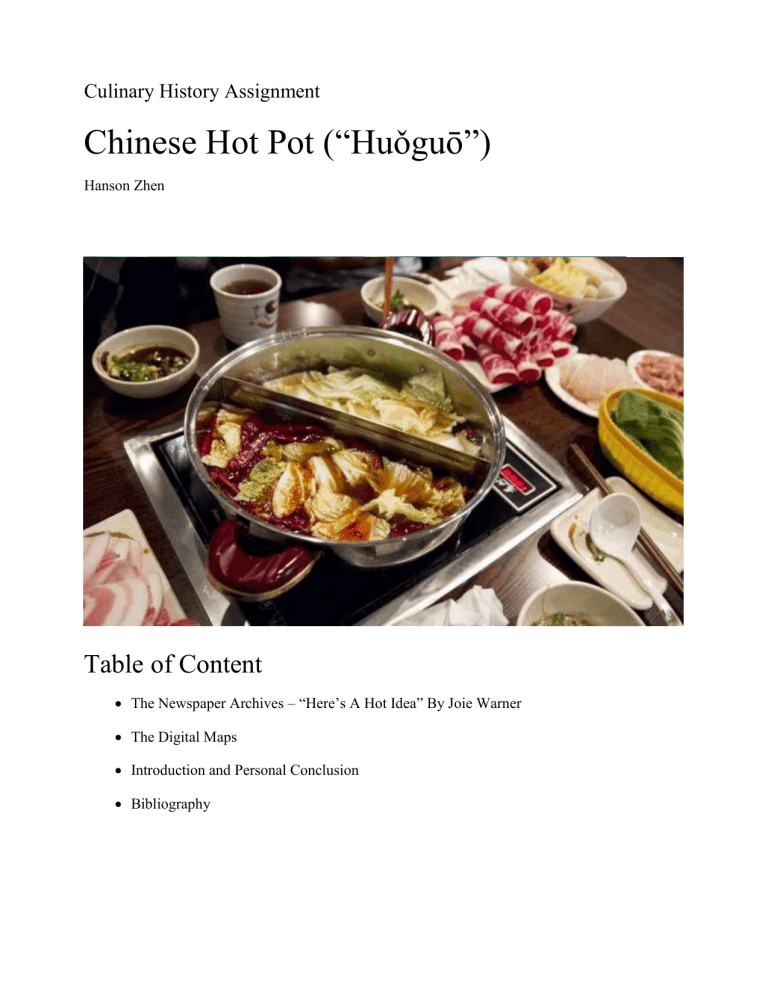
Culinary History Assignment Chinese Hot Pot (“Huǒguō”) Hanson Zhen Table of Content The Newspaper Archives – “Here’s A Hot Idea” By Joie Warner The Digital Maps Introduction and Personal Conclusion Bibliography The Newspaper Archives what a resident of that time might experience if they went searching for your cuisine. With barbeque as one of the many common western styles of cooking, hotpots worked in a similar manner where food is cooked through a medium until ready to eat. When the locals first tried dining in a hot pot restaurant, they were welcomed by the fumes of the chili broth, which later, Warner included tips such as keeping a window open for air to circulate1 the fumes outside of the restaurant. For the Canadians who want to bring the experience home, they would go to their local Chinatown and purchase the necessary utensils such as the huoguo pot and wired spoons to have hotpots with their loved ones at home, contributing to the spread of Asia’s culture. However, the equipment can be expensive. As a substitute, Warner provided some examples such as an electric pot or fondue pot will be sufficient for the broth, and chopsticks work just as well as the wired spoon, which is coincidently more traditional. 2 What basic ingredients, flavors, and manner of preparation might they encounter? The primitive stages of hot pot only consisted of the basic ingredients such as lamb with some coarse vegetables.3 As the history of hot pot continue to progress, it evolved from something that was considered “slightly barbaric” (Warner, 15) to slivers of meat such as chicken, and with additional ingredients such as seafood, bean curds, vegetable greens, and noodles.4 Possibly you might learn how newcomers to Toronto struggled to gain acceptance for their food, or conversely were more easily able to fit in because of it. Described as “One of the most spectacular and ingenious cooking utensils ever invented” (Warner, 1), the pot used for hot pot has become a symbol of the prosperous growth of Chinese culture in Toronto. While the hotpot industry may not always have its western customers, it will never fall short of its eastern customers. For the Chinese residents, the hot pot restaurants post as a beaker for the taste of home. Being in an environment that stimulates the sensory information of home can block out the intimidation of being in a foreign land, like that of an emotional haven. Paraphrased from Warner (116). “Here’s A Hot Idea” Paraphrased from Warner (72-79) 3 Paraphrased from Warner (11). 4 Paraphrased from Warner (16-17). 1 2 2 The Newspaper Archives The Hot Pot restaurant was isolated back in 1980, not near too many food restaurants, and from a marketing perspective, there are not that many competitors. However, from the 1980 maps, the Hot Pot restaurant was within the radius of a few Chinese restaurants such as Chinese Lanterns and Jade’s Chinese Food. This may suggest that the specific radius of the listed restaurants was mostly made up of eastern residences. Surprisingly the Hot Pot restaurant is still open to this day, in the same location. Unlike in 1980, the Hot Pot restaurant is now surrounded by other businesses such as marketplaces, local salons, and suit rentals. Perhaps due to the uprising of the market, the Hot Pot was the only local Chinese restaurant within the radius, which may also suggest that Hot Pot was more popular than the local Chinese restaurant back in 1980. 3 Introduction and Conclusion For the culinary history assignment, I chose one of China’s most traditional and popular cuisine, the hot pot. During my research in the archival search, there was only one article that provided a detailed insight into how the immigration of hot pot became one of the most popular food chains here in Toronto. This suggests that it was around the 1980s when hot pot was becoming more recognized in the food industry. The resident in the past may have been hesitant to try hot pot, as its chili aroma may not agree with the standard taste palette of Canadians. Now, hot pot has become more evolved in a way for it to be integrated into western society, by providing soup bases that vary in spice level to better accommodate its customers. With its exponential increase in popularity, there have been more restaurants that feature the hot pot, some with even creative styles of food delivery and different themed atmospheres. While the pot is used as the instrument to cook ingredients, huoguo itself has transpired as a medium that can bring family and friends together and enjoy a long leisurely supper.5 5 4 This is paraphrased from Warner (23-26) Bibliography Cover photo: Beginner’s guide to hot pot, Eatnorth, https://eatnorth.com/steph-tse/beginners-guide-hot-pot Warner, Joie. “Here's A Hot Idea.” 1985, https://www.proquest.com/hnpglobeandmail/docview/1151625248/BD7A45E90BB54BCCP Q/1?accountid=14771&parentSessionId=n2Ok8Q04GceLLsb9C77F%2BvAp5CF9cy526od Tg1B4Dn0%3D. Accessed 9 Feb. 2023. Google Maps, Google, https://www.google.com/maps/place/Hot+Pot+Restaurant/@43.6975927,79.4416515,19.9z/data=!4m6!3m5!1s0x882b3396b33fade3:0xbe828d76234e1362!8m2!3d43 .6974856!4d-79.4413285!16s%2Fg%2F11_qw65wn. ArcGIS Web Application, https://utoronto.maps.arcgis.com/apps/webappviewer/index.html?id=edb3f9698249464faa8c 53b6d008a941&extent=-8882593.5986%2C5381088.1907%2C8784754.2024%2C5435664.2289%2C102100&showlayers=1980_Updated_Restuarants_216 %3B1980_Metro_Toronto_Boundary_9851. 5


